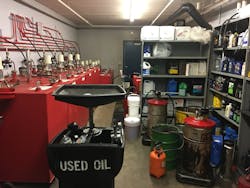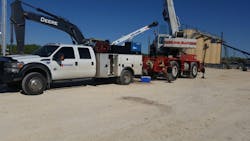For Oils, Managers Should Say, “Analyze This”
Long before anyone heard of Cologuard, some maintenance managers were extracting oil and fluids from their machines, boxing them up, and sending them to labs.
The return diagnosis can save a fleet from downtime, lost productivity, and repair costs, or even a catastrophic machine-component failure.
But for a consistent look at what’s happening inside vital fluids, maintenance pros have to take the first step, which is committing to regular analysis.
“A properly run regular oil analysis program will help determine the health of the equipment—if it is being contaminated and by what, if it is wearing prematurely, and possibly what is wearing, and if the unit is running excessively hot,” says Dan Holdmeyer, North America industrial sector manager for Chevron. “Additionally, oil analysis results can determine if the wrong oil is being used.”
Luke Miller, senior analyst with Blackstone Labs, mentions metals as a potential culprit.
“The best way to gauge the internal health of a system—engine, transmission, or hydraulics—is with wear-trend monitoring, which is how much metal a system is making from one service interval to the next,” he says. “Analysis is also a good way to determine the appropriate service interval for an engine. We might find evidence of the oil being run too long, or that the oil is still in good condition and can safely be run longer in the future. The savings in extended drain intervals for a healthy engine or system can be enough to cover the cost of analysis and then some.”
Choices for oil analysis
Blackstone is just one firm that serves a variety of analysis customers.
“The kinds of clients that use oil analysis cover the gamut from large contractors and OEMs to individual owner operators,” Holdmeyer says. “The level of usage varies widely along the spectrum of users. Some pull the sample, submit it and just file the results, while others have very specific procedures and routines for pulling proper samples and then take action on the results of the analysis.”
“We also do pre-buy work for equipment resellers,” Miller says. “They sample oil from a piece of equipment they are looking to buy to spot any major problems before committing to the purchase.”
Blackstone also receives samples from units already experiencing problems in the field. “The customer will use analysis as part of the diagnostic process,” Miller says. “For example, if an engine is ‘making oil,’ a sample might be submitted to check for coolant or excess fuel contamination.”
Working with a lab such as Blackstone will carry some initial cost, but, of course, the findings could save a lot of money later. At press time, the cost of the company’s standard analysis is $28.00 per sample. The kits are free, and the firm also covers the return shipping via USPS First Class Mail. Payment is usually made when the results report is completed.
“We also offer bulk discount rates for larger-volume customers, starting at six or more analyses,” Miller says. “There is no formal contract on our end, although bulk samples are paid for ahead of time in one lump sum rather than when the report is completed.” Requests for test kits can go through the company’s website or via phone.
Chevron’s Holdmeyer says the cost of an oil analysis is “anywhere from ‘included with the purchase of the oil’ to around $25 per sample and includes particle count analysis, which is very critical in today’s high-pressure, high-performing, precision equipment.
“To set up a program properly, operating conditions need to be considered to determine the sampling frequency of each component, as well as which ones to include,” Holdmeyer says. “Proper sampling techniques, or tools, need to be implemented, so that consistent, representative samples are obtained. Generally, no contract is needed, but it’s helpful to register the equipment components to be sampled so electronic tracking tools like bar code printers and readers can simplify maintaining proper sample identification—and thus an accurate sample result history.”
OEMs, though they likely contract out with labs for some or all of the analyses, naturally prefer managers go through their dealer networks. It’s often pitched as part of extended warranties or maintenance agreements. For example, John Deere’s Fluid Analysis program is part of the Customer Personal Service approach by the company’s dealer network.
A dealer’s Customer Support Advisor works with the fleet to set up the program. Typically, the dealer extracts the fluid samples, records the fluid and machine data, and sends a sample bottle and form to the lab.
Eight regional labs process the samples, usually the same day they’re received, Deere says. Samples are tested for chemical and physical properties. An emission spectrometer screens oil for wear metals, additives, and contaminants, and an automated viscometer measures the flow rate of oil in relation to time. Additional tests evaluate the indicators of engine, hydraulic, or transmission fluid degradation.
A Web-based report is generated for each machine with specific recommendations for actions; if samples indicate a serious problem, the customer is notified immediately by email, on the Deere website, or through a free mobile app. (Managers can also request the kits from dealers, extract their own samples, and send them to a lab.)
Common findings
Holdmeyer says the most common findings depend on the components involved.
“Engine oil samples that show coolant contamination, like potassium, sodium, and borate, would require immediate action to prevent catastrophic failure,” he says. “Coolant additives such as water and glycol will volatize off and won’t show up in engine oil analysis. Dirt contamination, with wear, in any component is common and should be addressed quickly to maximize equipment life.”
Miller says, “Some of the issues we come across are manufacturer-specific, and we try to keep up on what problems are common to particular engines or systems and how they show up in our tests. This information is often obtained by customer follow up on reports. We also maintain a database of common problems and how they’ve shown up in analysis.
“I would say contamination-related issues are more common than anything else,” Miller says. “Analysis can detect coolant contamination in the oil before the customer has noticed a loss of coolant or a change in the oil’s physical appearance.”
Silicon from abrasive dirt contamination is another common issue Miller sees.
“This might be from a loose intake fitting downstream of the air filter,” he says. “These problems can go unnoticed until internal damage has been done. If caught early on with analysis, the problem can often be corrected without causing long-term problems for an engine or system.”
Uncommon findings
Sometimes an analysis finds problems that turn into training opportunities for managers.
Mike Brennan, CEM, fleet manager for Manatee County, Fla., and a three-time Construction Equipment/AEMP Fleet Masters winner, says he’s seen many different things happen with oil and fluids.
Mike Brennan has some specific advice on oil analysis. Read more.
“We’ve found that techs have mistakenly put the wrong oils and lubricants in compartments,” Brennan says. “Sometimes we’ve been successful in finding that, sometimes we haven’t and we’ve had a problem. It all depends on your program, and how educated your people are on taking the samples. A lot of times, you’ll get a high silicate and you’ll be questioning that—did we contaminate the sample as we took it?
“So we take another immediately and send it off,” he says. “If if confirms what you have, maybe we have a problem. If it doesn’t, okay, maybe we contaminated the sample. It’s unfortunate, but it happens. That’s just a matter of educating the techs and the staff. Maybe we didn’t have time to clean the machine thoroughly before it came in,” Brennan says.
“The vast majority of samples we test look like what we expect for what the oil is and what it came out of,” Miller says.
And then there are these instances.
“Several years ago, we tested hydraulic oil from a fertilizer spreader. The potassium was very high, and that’s not an element you should find much of in hydraulic oil,” Miller says. “We come to find out the hydraulic tank was topped off with fertilizer, and that was the suspected source of potassium.
“We also come across some interesting approaches to maintenance,” Miller continues. “I have seen 75W/90 gear lube run in an engine because a customer heard it offered better wear protection than engine oil. This practice isn’t something we’d recommend!”
“The main goal of oil analysis is to catch developing internal issues before they become a major problem,” Miller says. “This might be poor wear from a developing problem with internal parts, or contamination that may eventually lead to poor wear or other issues.”
Either way, it’s wise to use oil analysis to crack the case.

